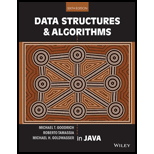
Concept explainers
Explanation of Solution
Recursive method to determine the sum of two elements is equal to “n”:
Create the method FindPair() that accepts the input parameter as “a”, “low”, “high”, and “n” to determine the sum of two elements in an array “a” is equal to “n” by calling this method recursively.
Method definition:
//Define the FindPair() method
public static boolean FindPair(int a[], int low, int high, int n)
{
//Check whether the "low" is equal to "high"
if(low == high)
/*Return false, if there are no elements in array "a" that sum is equal to "n". */
return false;
/*Otherwise, check whether the sum of "a[low]" and "a[high]" is less than "n". */
else if((a[low]+a[high]) < n)
/*Call FindPair() method recursively by passing the parameters as "a", "low+1", "high" and "n" to sum the two elements is equal to "n". */
return FindPair(a, low+1, high, n);
/*Otherwise, check whether the sum of "a[low]" and "a[high]" is greater than "n". */
else if((a[low]+a[high]) > n)
/*Call FindPair() method recursively by passing the parameters as "a", "low", "high-1" and "n" to sum the two elements is equal to "n". */
return FindPair(a, low, high-1, n);
else
/*Return true, if there are elements in array "a" that sum is equal to "n". */
return true;
}
Explanation:
In the above code,
- In the FindPair() method,
- It accepts the input parameter as “a”, “low”, “high”, and “n”.
- Check whether the “low” is equal to “high”. If yes,
- Return false, if there are no elements in array “a” that sum is equal to “n”.
- Otherwise, check whether the sum of “a[low]” and “a[high]” is less than “n”. If yes,
- Call FindPair() method recursively by passing the parameters as “a”, “low+1”, “high”, and “n” to sum the two elements is equal to “n”...
Want to see the full answer?
Check out a sample textbook solution
Chapter 5 Solutions
Data Structures and Algorithms in Java
 C++ Programming: From Problem Analysis to Program...Computer ScienceISBN:9781337102087Author:D. S. MalikPublisher:Cengage LearningProgramming Logic & Design ComprehensiveComputer ScienceISBN:9781337669405Author:FARRELLPublisher:Cengage
C++ Programming: From Problem Analysis to Program...Computer ScienceISBN:9781337102087Author:D. S. MalikPublisher:Cengage LearningProgramming Logic & Design ComprehensiveComputer ScienceISBN:9781337669405Author:FARRELLPublisher:Cengage C++ for Engineers and ScientistsComputer ScienceISBN:9781133187844Author:Bronson, Gary J.Publisher:Course Technology Ptr
C++ for Engineers and ScientistsComputer ScienceISBN:9781133187844Author:Bronson, Gary J.Publisher:Course Technology Ptr Systems ArchitectureComputer ScienceISBN:9781305080195Author:Stephen D. BurdPublisher:Cengage Learning
Systems ArchitectureComputer ScienceISBN:9781305080195Author:Stephen D. BurdPublisher:Cengage Learning New Perspectives on HTML5, CSS3, and JavaScriptComputer ScienceISBN:9781305503922Author:Patrick M. CareyPublisher:Cengage Learning
New Perspectives on HTML5, CSS3, and JavaScriptComputer ScienceISBN:9781305503922Author:Patrick M. CareyPublisher:Cengage Learning Programming with Microsoft Visual Basic 2017Computer ScienceISBN:9781337102124Author:Diane ZakPublisher:Cengage Learning
Programming with Microsoft Visual Basic 2017Computer ScienceISBN:9781337102124Author:Diane ZakPublisher:Cengage Learning





